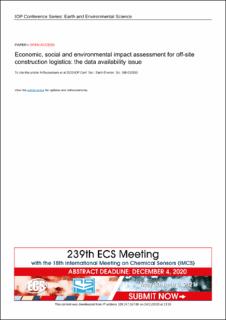| dc.description.abstract | Introduction. The ongoing urbanization trend makes local governments densify their built environment, hence stimulating construction and renovation works in urban areas. Construction intrinsically strongly relies on logistics activities, which in turn are the source of environmental nuisances. The latter are referred to as external costs when they are not borne by the polluter himself, such as greenhouse gas emissions, air pollution, congestion, etc. Accurate external cost calculations require accurate data to consider significant calculation-variables. However, current calculations are often based on the number of vehicles used and on transported volume rather than vehicle- or tonne-kilometres, hence not adequate to conduct external cost calculations. Methods. The MIMIC-project1 aims to reduce the impact of construction logistics. Therefore, an integrated impact assessment framework will be developed, assessing the economic and environmental influence of different off-site construction logistics solutions. The necessary data to conduct such an impact assessment are however not always available, complicating calculations. This paper highlights the current gap in accurate data on urban construction logistics flows, the considerable uncertainty about existing figures on construction transport and their methodology, and presents the data availability issue in the development of such a framework, using empirical research. Results. Logistics flows data are typically scattered amongst different actors and various in format. Harmonizing different data categories and sources to feed the framework with relevant logistics variables, this paper presents what is possible to calculate using available data in 4 pilot cases in Belgium, Sweden, Norway and Austria. The various data sources highlight the complexity to develop a framework flexible enough to cope with specific local constraints, whilst generic enough to allow comparability across the European cases, and ultimately across construction logistics globally. Furthermore, a shift is needed towards other data collection methods (GPS, digital waybills etc.). Conclusions. This paper presents the data availability issue in the development of an impact assessment framework for construction logistics, harmonizing different data sources in order to conduct external cost calculations for construction transport. | en_US |

